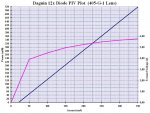IgorT
0
- Joined
- Oct 24, 2007
- Messages
- 4,177
- Points
- 0
So, Dave, i'm just starting to read through the thread, but was any testing done already, or not yet? Like a PIV plot i mean?
In any case, for me, the sled being the same as 8x is a GOOD sign, not a bad one...
If the sled was completelly different looking, what would you have done with the diode by now?
If the sled was completelly different there is actually a better chance that the same diode is used..
What now?
In any case, for me, the sled being the same as 8x is a GOOD sign, not a bad one...
If the sled was completelly different looking, what would you have done with the diode by now?
If the sled was completelly different there is actually a better chance that the same diode is used..
ah, igor, come on! you cant be offline or asleep now, can you? quick, someone call and alarm him!
manuel
What now?
Last edited:




